Unfinished ships in periods of decline of Russian statehood
The Navy, being an integral part of the armed forces, is highly vulnerable to differences in the domestic climate. Being a very complex structure in all respects, it has a heightened sensitivity to abrupt changes in the political barometer - the fleet is rapidly losing its combat capability, the technical condition of the ships goes down along the curve, the bases and stopping places subside, the shipyards freeze. Newborn steel children of plants freeze at the outfitting walls, others are less lucky - their embryos grow into abandoned stocks.
Twice domestic the fleet during the XX century had to endure timelessness, when the unfinished ships remained on the stocks.
Overcoming the tragedy of the Russian-Japanese war, the Russian Empire’s navy was forced to undergo a quality full reboot. Lessons were learned, concepts and attitudes changed, stereotypes and archaic remnants of the past swept away. The world has entered the era of dreadnoughts, preparing for new wars.
Gaining strength. New fleet
The Black Sea Fleet escaped the fate of the I and II Pacific squadrons in Port Arthur and in the Tsushima defeat. Its quantitative composition has changed not so catastrophically as in the Baltic. He was scorched by the flames of the First Russian Revolution - for a long time in the mist of the horizon from the shore rebellious Potemkin was seen, and the grave of Peter Schmidt, the captain of 2 rank, was overgrown with grass on the island of Berezan. In 1910, the elderly Ottoman Empire remembered its glorious naval past and decided to shake antiquity. A new program was adopted, designed to strengthen the very decrepit and low-performing Turkish fleet. Scratching the bottom of the barrel, collecting part of the funds by public subscription, the Turks decided to order two battleship dreadnought in England. Work on the first ship, the Reshadie, began in 1911.
Of course, the Russian command could not disregard these attempts of their restless neighbor to return to the club of the big sea powers. The calculations were disappointing - almost all the battleships (from 1907, the battleships) of the Black Sea Fleet, including the relatively new post-Susim "John Chrysostom" and "Evstafy", were qualitatively inferior to the promising enemy. The core of Russia's naval forces on the Black Sea was slowly turning into a retirement club. An adequate response was required, and it was found: in 1912, the “Program of enhanced shipbuilding” was adopted, where great importance was attached to the Black Sea Fleet. It was planned to build the 3 battleship dreadnought according to improved drawings of the Baltic Sevastopol, 4 light cruisers, 12 destroyers, 8 submarines. The main shipbuilding load was to lie at the shipyard of Nikolaev, the second most powerful shipbuilding center of the empire.
The situation in the Black Sea basin continued to deteriorate - even though the Turks refused to acquire the second dreadnought (the construction of the first went on credit), at the beginning of 1914, they managed to outbid (again, not without the help of loans) the unfinished Brazilian battleship and on the security of the jewels of ousted Sultan Abdul Hamid ordered third battleship. In Petersburg, they justifiably expressed alarm with similar military preparations; after all, such ships were not built for catching Greek smugglers. In the year 1914, another shipbuilding program was adopted to strengthen the Black Sea Fleet. It was planned to put into operation another dreadnought, the newest destroyers of the Novik family and submarines. True, for Russia itself, such extensive naval preparations caused certain difficulties: there was not enough financial resources, some of the technical equipment had to be ordered abroad due to technical backwardness and underdevelopment of some technologies.
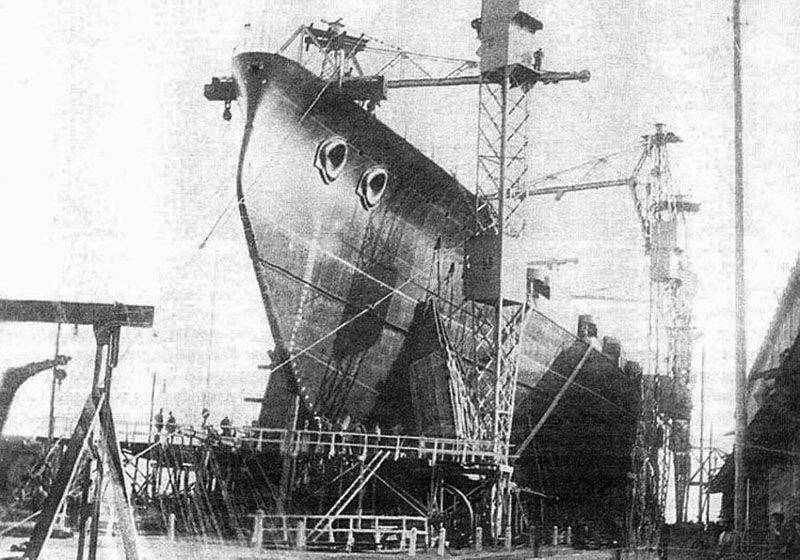
With the beginning of World War I, the shipyards and, first of all, Nikolaev were loaded with military orders. At the Russud plant, the construction and completion of the battleships Empress Maria and Emperor Alexander III were in full swing. The society of Nikolaev factories and shipyards (ОНЗИВ) worked on the "Empress Catherine the Great", laid down in the pre-war 1914 year according to the improved project of the talented engineer Vladimir Kostenko. The clearly inadequate cruising forces of the fleet, consisting on the 1914 of the year from the no longer new "Kagula" and "In Memory of Mercury", were to be replenished with ships of the newest construction. On the "Russud" was the construction of the cruisers "Admiral Nakhimov" and "Admiral Lazarev." After the ONZIV, he lays in his 1914, two Admiral Istomin and Admiral Kornilov of the same type. Along with the large ships was expected replenishment and light forces - destroyers. In the autumn of 1914 - in the spring of 1915, the fleet was replenished with 9-th squadron destroyers of the type “Daring”, built (except for two, assembled at the private shipyard of Vadon in Kherson) in Nikolaev. They became the first serial turbine destroyers of the Russian fleet, the famous Novik was taken as the basis of the project. The project was so successful that it was decided to build additional ships of this class. They were called "Ushakovskaya" series - the destroyers carried the names of the victories won by Admiral FF. Ushakov. 1915 destroyers were laid in the 1916-8, of which 4 came into operation at the time of the October Revolution. In the second half of 1916, work began on the second "Ushakovskaya" series, which already consisted of 16 ships. Only the first 3 of them were named.
By the beginning of World War I, a new type of armament and a class of ships — submarines — had clearly emerged. In 1914, in Nikolaev, 3 submarines of the “Narval” type were built according to the design of the American firm “Holland” and the first in the world underwater mine layer “Crab”. During the war 5 Pelican-type submarines (improved Baltic Bars) were laid, lowered and put into operation. In 1917, the assembly of the first boats purchased in the USA, which received the name "AG" - "American Holland", began. The dismantled submarines that arrived on the ship to Vladivostok were transported by rail to Nikolaev, where they were to be assembled.
Despite the outbreak of war, Nikolaev’s plants were able to maintain a fairly high rate of commissioning of new ships, given that long-term construction was a constant feature of the domestic shipbuilding industry. Built with quality. Looking around the battleship General Alekseev in 1924 (formerly Emperor Alexander III), which was stationed in Bizerte, the French commission noted the excellent quality of anchorage armor.
Revolution. Inside the storm
The social processes that took place at the beginning of 1917 in the country affected all aspects of the life and work of the Russian Empire, and now the republics. The growing wave of chaos and collapse began to hurt the most vulnerable nodes - industry and transport. Gradually, interruptions in the supply of necessary materials and equipment increased, plants shook strikes (this was during wartime). It is impossible to blame monopoly on all those misfortunes and crisis phenomena on the then small Bolshevik Party, which had nothing to do with the government of that time. In February, 1917, the levers of governing the country, which, however, began to immediately bruise, were seized by representatives of the propertied classes and intellectuals. Very soon, the entire country felt the fullness and depth of the incompetence of the Kerensky government. The stormy and frankly wrecking activities in the armed forces have been reduced to the abolition of officer shoulder straps and saluting, as well as the renaming of a number of ships. By the fall of 1917, the following ships were in different degrees of readiness in Nikolaev: the battleship with the characteristic name “Democracy” (formerly “Nicholas I”), the 4 light cruisers of the type “Admiral Nakhimov”, the 4 destroyer of the first “Ushakovskaya” series, 3 - the second. The first 3 6 submarines of the “AG” type were assembled, and the 5 Pelican-type submarines were slowly completed. In addition to the ships of the main classes, work was carried out on a series of multipurpose gunboats of the Elpidifor type and a number of other small ships and vessels.
This entire conglomerate of ships and vessels fell victim to the situation, being chained to the outfitting walls and stocks. Revolutionary and not only whirlwinds raged outside the gates of the enterprises. Power was changing like a kaleidoscope. The fragile structures of the Provisional Government fell apart. As soon as the Bolsheviks appeared after them in the city, the Germans drove out - Nikolaev entered the German zone of occupation under the terms of the Brest Peace. The city and factories were visited by representatives of German firms, primarily Blohm & Voss, which before the war cooperated with Nikolaev enterprises. Of course, the question of even a hypothetical completion of some ships was not raised - Germany in the summer of 1918 was not in a position to engage in such projects. The resources of the German shipbuilding industry were devoted primarily to the construction of submarines. The construction of a number of large ships was suspended, for example, the superdreadnoughts Saxe and Württemberg. The unfinished battleship Salamis (by order of Greece) has been rusting since 1914. So there was no talk of any kind of shipbuilding activity for the Germans in Nikolaev. It was planned to dismantle and take out some equipment and materials in Germany, but in November 1918 a revolution broke out, and then a truce, and the Germans had no time for ships, especially unfinished ones.
After the Germans left, the Ukrainian Directory flashed, passing the baton to the authorities, first to the Franco-Greek Expeditionary Corps, then to the Armed Forces in southern Russia. Only, perhaps, the whites tried to bring at least some order in the factories: they were able to partially put into operation an unfinished destroyer Tserigo and three gunboats of the Elpidifor type. In the end, they shared the fate of the Bizertsky squadron and were scrapped. The White Admiral, the most ready in the hull, the White Command, was planning to use it as an evacuation vehicle from the Crimea, but when towed to Odessa, it was stranded and abandoned.
Will and mind. The revival of the fleet
The civil war and related events caused enormous damage to the entire economy of the young Soviet state. Enterprises have been destroyed and looted - many resources have been exported abroad, and not without the help of yesterday's “valiant” allies.
The new government vigorously took up many aspects and the restoration of the fleet in particular. The foreign policy environment of Soviet Russia was not friendly. Through the efforts of the Reds (flooding in Novorossiysk), “allies” (leaving Crimea, a number of ships, including the newest ones) were put out of operation and flooded, whites (leaving Bizerte) the Black Sea fleet turned into a handful of watercrafts, fighting whose effectiveness was nearing zero. In 1922, the first measures were started to inspect and complete the construction of the ships of the royal bookmark. Thus, the Soviet government took care to restore its presence on the Black Sea just five years after coming to power in 1917, and two years after the end of the Civil War. Not all ships were possible and expedient to restore. It was decided to abandon the completion of the battleship "Democracy", the two extreme cruisers of the type "Admiral Nakhimov", the destroyers of the second "Ushakovskaya" series, some other ships and ships. Long standing at the plant wall and frequent change of power did not benefit the fourth Black Sea dreadnought. Its internal equipment was rendered unusable, the completion required a large amount of resources, which the country did not have at that time. Performance characteristics by the middle of 20's were already inadequate.
Only that which had a sufficiently high degree of readiness was repaired and put into operation. The plants were restored, their activity was gradually adjusted and normalized, although the lack of technical equipment and personnel hunger was felt for a very long time. As a result of the strenuous activity of the Soviet leadership, by the beginning of the 1930-s, Nikolayev’s factories could begin building new-generation ships already under Soviet projects. By the beginning of the 1940s, shipyards were working on ships that were most complex at that time: battleships of the Soviet Union type, the 69 Sevastopol battle cruiser, and the 68 lightweight cruisers of the Chapayev type. But the next big war prevented the plan to create a national ocean fleet.
Strength and power. Post-war shipbuilding
From the inland and coastal into the ocean Soviet fleet turned into the second half of the 1960-ies, after a kind of Khrushchev experiments with a massive reduction in the number of all types and types of troops, mass cutting of ships under construction into metal and the disposal of bombers and fighters just left the factory.
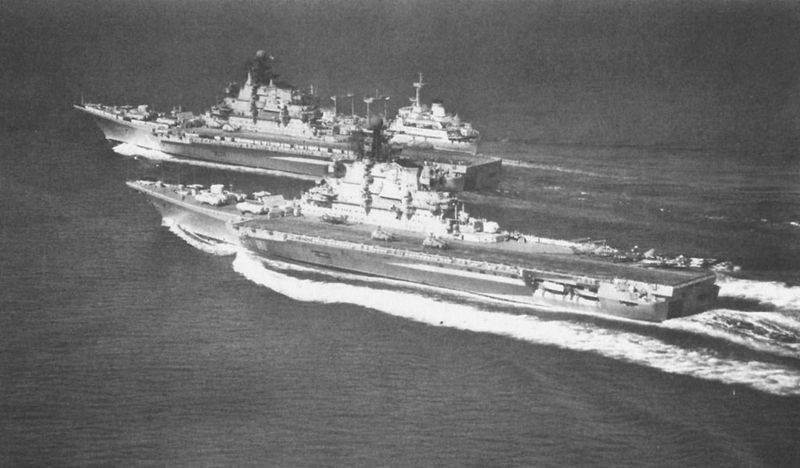
At this historical stage (1970-80-s) the navy of the Soviet Union reached the peak of its quantitative and qualitative development. It consisted of a large nomenclature of ship classes - from armored boats to strategic nuclear submarines. All that was missing was aircraft carriers that, in the shipbuilding programs of the USSR, had been in the position of stepchildren since the 1930's. They refused to build them, they postponed them for later, and then there were some other reasons. By the end of 60, the strategic tandem of Marshal Grechko and Admiral Gorshkov finally pushed through the idea of building aircraft carriers. And they should have been built in Nikolaev. The 1123 “Moscow” and “Leningrad” antisubmarine cruisers were followed by a much larger and more advanced “Kiev” (the 1143 “Krechet” project). Behind him are “Minsk”, “Novorossiysk” and “Baku” somewhat different from them. With undoubted merit (powerful airborne missile weapons), these ships were not effective enough in their main specialization - as an air group. The Soviet Yak-38 vertical take-off aircraft was in many respects inferior to its main foreign competitor, the British Harrier. He had a limited combat load, a complex system of take-off and landing. Yak-38 did not have its own radar station, which called into question the possibility of conducting air combat. With a tonnage of 45 thou. Tonnes, the 1143 ships had an efficiency of an onboard aviation group at half the size of the British Invinsible and were significantly inferior to the French Clemenceau aircraft of comparable size.
A full-fledged aircraft carrier was required, capable of carrying horizontal take-off and landing aircraft. The development of such a ship project 1160 "Eagle" began at the turn of 60-70-s. The aircraft carrier was supposed to have a displacement of 80 thousand tons, a nuclear power plant and would be able to carry about 70 aircraft. Replaced A.A. Grechko as minister of defense, Marshal Ustinov, did not burn with the idea of commissioning such ships, considering it to be expensive.
Overcoming the lobby of the “fighters with an imperialistic type of armament”, Gorshkov and his supporters in the Military Industrial Complex were able to push the decision to build more modest 1143.5 heavy aircraft carrier cruisers than the “Nimitz” in the Soviet way so far the only heavy aircraft carrier cruiser of the USSR and Russia.
Needless to say, when building such fundamentally new ships for the Soviet shipbuilding industry, an enormous number of scientific, technical, industrial and military tasks were being solved. The construction of an actually multi-purpose aircraft carrier of such size and complexity could only be afforded by a superpower, which the Soviet Union was at that time.
September 1, 1982 at the Black Sea shipbuilding plant laid the heavy aircraft-carrying cruiser Riga, which was soon renamed Leonid Brezhnev. With a normal displacement of 53 thousand tons, the ship was intended for basing about 50 aircraft, among which were the latest Su-27 and MiG-29 fighters. Despite some features: strong missile weapons, unlike their Western counterparts, the absence of steam catapults and the presence of a springboard take-off deck, it was a full-fledged aircraft carrier, the first in the USSR Navy. At another Nikolaev enterprise, the plant named after 61 Communards, work was already in full swing on the construction of the Project 1164 Atlant missile cruisers, alternatives to the too expensive Orlan Project 1144 nuclear ships manufactured in Leningrad. The Atlanteans were to give additional combat stability to Soviet naval formations. A bunch of the latest missile cruisers, covered already full deck aviation with promising aircraft carriers, she created a balanced and effective mechanism for the fight against American AUGs in different parts of the World Ocean. After the Brezhnev launched in 1985 on December 6 of the same year, the laying of the second ship of project 1143.6 takes place, which was again named Riga, which sometimes causes confusion.
In parallel with the construction of heavy aircraft-carrying cruisers, the Black Sea Shipyard is undergoing a qualitative modernization and expansion of production. The newest equipment goes to the enterprise, the shops are expanded, the construction of a special outbuilding embankment especially for aircraft carriers ends. The funds and resources invested in the plant (which costs only the installation of two gantry cranes with a lifting capacity of 900 tons) make CSY one of the most technologically advanced shipyards in Europe. The company is ready to build the next, nuclear, aircraft-carrying cruisers of the 1143.7 project.
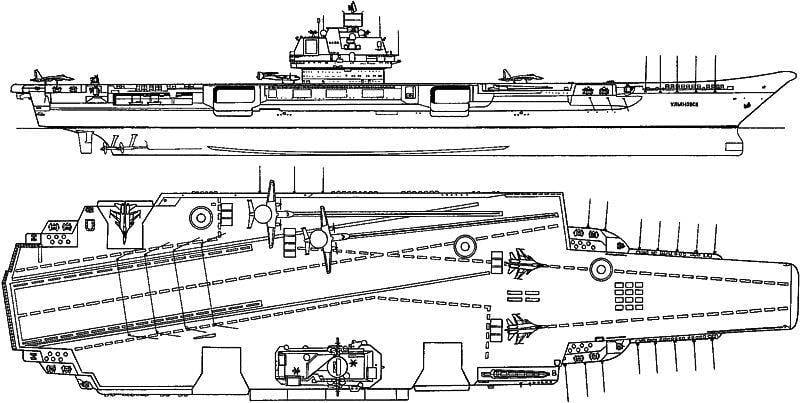
The bookmark of the first one, called “Ulyanovsk”, took place immediately after the descent of “Riga” - in 1988. For the construction and installation of a nuclear power plant, a unique, unparalleled equipment was created, for example, a workshop which was partially submerged on pontoons, in which the installation of reactors for Ulyanovsk was to be carried out. According to various sources, by the current year, 2015, it was planned to commission the 6 nuclear aircraft carrier cruisers. There is no doubt that a country like the USSR would have succeeded.
The plant named after 61 of the Communard is also modernizing and expanding its facilities: the construction of new workshops begins, the reconstruction of old ones is under way. At the same time, the company successfully manages the construction of the 1164 rocket cruisers, the 537 Octopus rescue ships, the construction of civilian ships and numerous ship repair works. Soviet shipbuilders stood at the new frontiers and peaks, which would undoubtedly be taken and subdued. But story went the other way.
Rust flakes
Once again, the qualitative and quantitative development of the already created ocean fleet was interrupted. And not because of revolution or war. Perestroika, which quickly collapsed, made its inexorable adjustments to all aspects of the life of the Soviet Union.
Unable to withstand the experiments of a handful of illiterate liars and demagogues, to which the definition of "enemies of the people" is best suited, the USSR collapsed under the weight of accumulated unresolved problems. Together with the death of the state, many projects, developments and research have sunk into oblivion. The price of availability of cheap “jeans”, two hundred varieties of artificial sausage and variegated liners from chewing gum was high. It was paid for by not taking off "Buran", not lowered ships, not built nine-story buildings.
Nikolaev remained in the composition of the declared independent Ukraine. Varyag, which stood at the extension wall of the TAKR (it was this name that Riga received in 1990) and brought to 70-percent readiness for descent, Ulyanovsk became hostages of the situation. In the process of construction there was also a reconnaissance ship of the 12884 project “Transnistria”, which later became the Ukrainian management ship “Slavutych”. 27 December 1991 of the year at the Black Sea Plant was launched the last naval base ship for the unloading and neutralization of the submarine reactors of the 2020 project (order number XXUMX). Canned and rusting, the mother ship still stands in the water area of the plant.
At the 61 plant of the Communard, the fourth missile cruiser of the 1164 project "Admiral Lobov", launched in 1990, froze. In the same place on repair there was one-type "Glory".
Turned out to be the heiress of a huge amount of military property inherited from the Soviet Union, Ukraine was unable to complete the construction of the ships in Nikolaev. Their fate was dramatic. Located in the 67-percent readiness and delivered to conservation by VN in 1992, Varyag under the 1993 agreement of the year between Russia and Ukraine went to the Independent Square. What to do with such a ship, the Kiev leadership had no idea. But the unfinished aircraft carrier was the subject of close attention of the People's Republic of China. Having performed a brilliant operation through a front-end firm to acquire for the 20 million dollars of an unfinished Varyag, China gained access to technologies that the USSR and years spent billions of years to develop. In 2000, the aircraft carrier left Nikolaev forever. The ship began to tow to the Far East. Turkey, under US pressure, initially did not let the caravan through the Bosphorus, demanding payment of various fees. 16 months "Varyag" restlessly dangling in the Black Sea, waiting for the good of Istanbul at the passage of the straits. All this time, the main builder of the heavy aircraft-carrying cruiser Sergey Entis was in tugboats replacing each other. He accompanied his child to the campaign. In the end, after settling diplomatic nuances, the ship was towed to the shipyard in Dalian.
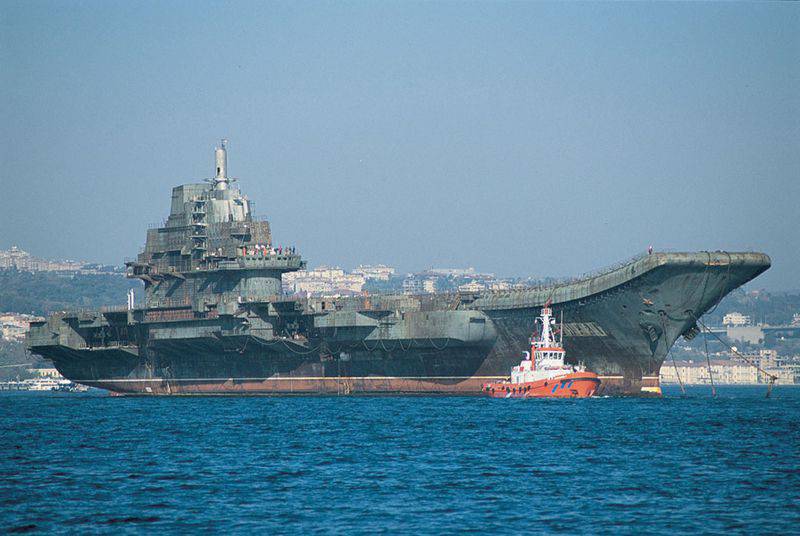
The construction of "Ulyanovsk" was suspended immediately after the collapse of the USSR, the question of its completion was not raised. In February, 1992 began dismantling the ship for metal. Not lowered nuclear aircraft carrier cut with the same enthusiasm as they built - around the clock. In October 1992, the “zero” (carrier) slipway was already empty. The entire territory of the plant was littered with piles of chopped ship steel, which was eventually sold for a pittance.
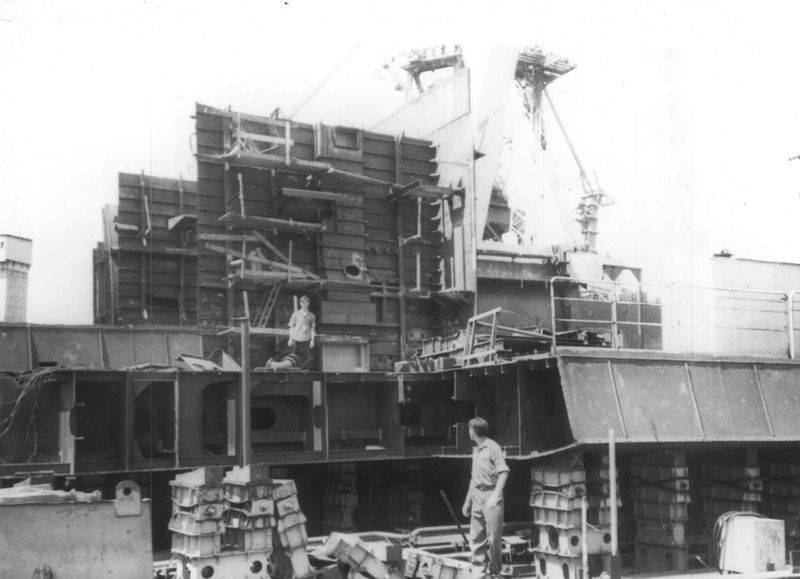
Standing at the 61 plant of the Communard "Admiral Lobov", which became the property of Ukraine, it was planned to be put into operation. The cruiser was called "Ukraine". Three times the team was formed and dissolved. Solemnly, the flag was raised and lowered. In the end, the fate of the unfinished ship is still in question. Repair of "Glory", renamed the "Moscow", was generally over by 2000 year - the ship under the flag of St. Andrew’s went to Sevastopol.
Is the future predetermined?
The state of the Nikolaev shipbuilding plants was constantly deteriorating: the lack of orders and the necessary funding, the systematic looting of everything of even the smallest value turned the developed enterprises into ruins. Now ChSZ and the plant of the name Communard 61 resemble landscapes of the famous game "Stalker". The out-of-town embankment, where new aircraft carriers were to be manned, was chosen by the Nibulon enterprise selling chemical fertilizers. Timelessness and decline have been going on for almost a quarter of a century, and so far there are no signs of a change in the situation for the better. Now it takes just incredible efforts to try to reach the intellectual, scientific and technical level that the USSR possessed at the turn of 80-90-XX. Rusting communities, like monuments of a bygone era, are the gantry cranes of the ChSZ plant, covered with brown streaks, stuck to the extension wall "Ukraine", or rather, this is just a floating object, excluded from all lists, except for sale.
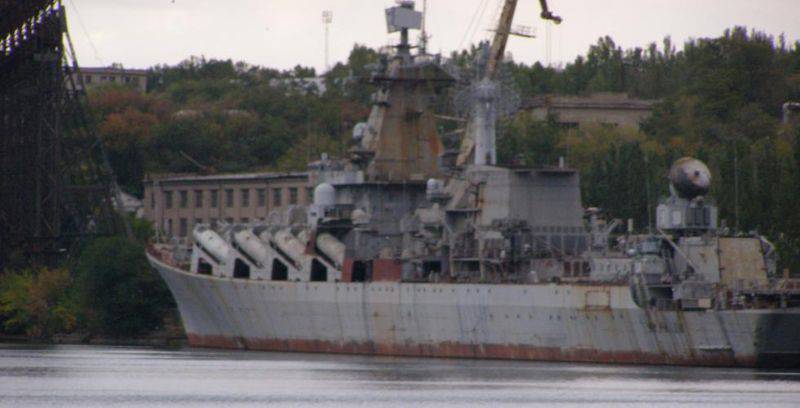
The desire of many citizens of Ukraine to turn their homeland into a small cozy European country, as well as help in reducing the resources and population provided by Western "friends", leaves no hope for the revival of shipbuilding.
However, domestic history knows many periods of decline of the state and all its institutions, after which inevitably began to rise. The revival of shipbuilding is the lot of a large and strong state that founded a shipyard in the mouth of the Ingul, which became the shipbuilding center on the Black Sea.
Information